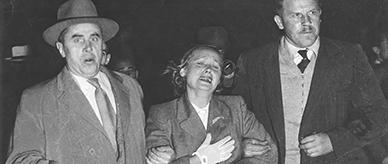


Transcript
[Letterhead: 'DEPARTMENT OF EXTERNAL AFFAIRS', 'OUTWARD CABLEGRAM'.]
[Right margin is shaded blue with black text 'CONFIDENTIAL'.]
GSW
0.63881
SENT 14/9/68
1226 LT
TO
AUSTRALIAN CONSULATE-GENERAL,
GENEVA [underlined]...... 1672
REPEATED
AUSTRALIAN MISSION TO UNITED NATIONS,
NEW YORK [underlined] ….. 853,
AUSTRALIAN EMBASSY,
WASHINGTON [underlined] …. 3215
AUSTRALIAN EMBASSY,
VIENNA [underlined] …. SAV. 18.
[Underlined heading:] CONFIDENTIAL.
[Underlined heading] DECLARATION OF "NON-USE" OF NUCLEAR WEAPONS.
YOUR 1382 N0. 20.
WE AGREE WITH POSITION EXPRESSED IN YOUR PARAGRAPH 6.
OUR PRELIMINARY COMMENT IS THAT UNDER ANY FORMULA WHICH MIGHT EVENTUALLY EMERGE WE WOULD WANT TO BE IN A POSITION TO CALL ON OUR ALLIES FOR NUCLEAR SUPPORT IF FACED WITH OVERWHELMING ATTACK BY CONVENTIONAL FORCES FROM WHATEVER SOURCE.
[Dividing line.]
MIN. AND DEPT E.A. [Minister and Department of External Affairs.] (910/10/6)
MIN. AND DEPT. [Minister and Department] DEFENCE.
A.A.E.C. [Australian Atomic Energy Commission.] (S) T/T
NAT. DEV. [National Development.]
TRADE AND INDUSTRY.
SUPPLY
A.G.'S DEPT[.] [Attorney-General's Department]
P.M.'S DEPT[.] [Prime Minister's Department]
D.C.O. [Department of the Cabinet Office]
P.M.'S [Prime Minister's.]
16/9/68
SEC FAS (1) AS(JIC) SEA DL INT FAS(2) UN(A) PACAM AMSP
PPO SA FAS(3) ER FAS(4) EAMEC E L AND T LA ICR [Added by hand in black ink:]PIO
About this record
A confidential cablegram sent to Australian representatives in Geneva, New York, Washington and Vienna.
Educational value
-
The cablegram documents Australia's initial concerns over the economic and strategic implications of signing the NPT, specifically because Australia, as a non-nuclear weapon state (NNWS), may wish to call on its allies for nuclear support if it were to come under attack. At the time, Australia sought alliances based on strategic national security needs, and did not want the NPT to weaken its position.
-
The treaty referred to was signed by the Gorton government, supported by the Australian Atomic Energy Commission (AAEC), with reluctance. The government would have preferred not to sign the treaty, but apparently succumbed to mounting pressure from the United States. Both the DEA, a supporter of non-proliferation, and the Department of National Development through the pro-nuclear AAEC, were involved in the development of nuclear policy at the time.
-
The document's reference to 'Paragraph 6' specifically relates to an exemption to non-use of nuclear weapons in the situation where one NNWS attacks another NNWS with conventional weapons. This was particularly relevant to Australia because of its isolated geographical position and proximity to a politically unstable Asia-Pacific region. The Australian Government was seeking assurances that signing the NPT would not leave it unprotected if such circumstances were to occur.
-
The document refers to the 1968 NPT which aims to prevent the spread of nuclear weapons while ensuring access to peaceful nuclear technology under International Atomic Energy Agency safeguards. The multilateral treaty was negotiated during the politically intense Cold War period and was the result of concerted international efforts for disarmament and to curb the use of nuclear weapons.
-
The NPT was declared on 5 March 1970. Australia signed the treaty in February 1970 but did not ratify it until a change of government in 1973. The five nuclear weapon states were those that had detonated nuclear weapons prior to 1967. They were China, the United States, Britain, France and the former Soviet Union. All other signatories were considered non-nuclear weapon states.
Acknowledgments
Learning resource text © Education Services Australia Limited and the National Archives of Australia 2010.
Related themes
Need help with your research?
Learn how to interpret primary sources, use our collection and more.



